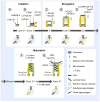Building the centriole
- PMID: 20869612
- PMCID: PMC2956124
- DOI: 10.1016/j.cub.2010.08.010
Building the centriole
Abstract
Centrioles are conserved microtubule-based organelles that lie at the core of the animal centrosome and play a crucial role in nucleating the formation of cilia and flagella in most eukaryotes. Centrioles have a complex ultrastructure with ninefold symmetry and a well-defined length. This structure is assembled from a host of proteins, including a variety of disease gene products. Over a century after the discovery of centrioles, the mechanisms underlying the assembly of these fascinating organelles, in particular the establishment of ninefold symmetry and the control of centriole length, are now starting to be uncovered.
Copyright © 2010 Elsevier Ltd. All rights reserved.
Figures




References
-
- Gönczy P, Echeverri C, Oegema K, Coulson A, Jones SJ, Copley RR, Duperon J, Oegema J, Brehm M, Cassin E, et al. Functional genomic analysis of cell division in C. elegans using RNAi of genes on chromosome III. Nature. 2000;408:331–336. - PubMed
-
- Kirkham M, Muller-Reichert T, Oegema K, Grill S, Hyman A. SAS-4 is a C. elegans centriolar protein that controls centrosome size. Cell. 2003;112:575–587. - PubMed
-
- Leidel S, Gönczy P. SAS-4 is essential for centrosome duplication in C. elegans and is recruited to daughter centrioles once per cell cycle. Dev Cell. 2003;4:431–439. - PubMed
Publication types
MeSH terms
Grants and funding
LinkOut - more resources
Full Text Sources

